Prior to departing departing for our Florida home we visited several parks and preserves near our northeastern Illinois condo. While not expecting a riot of yellow, orange, gold and red as experienced in New England, we hoped to see some fall color.
Before the first frost, a touch of yellow as this Clouded Sulphur butterfly visited a lingering Dandelion:
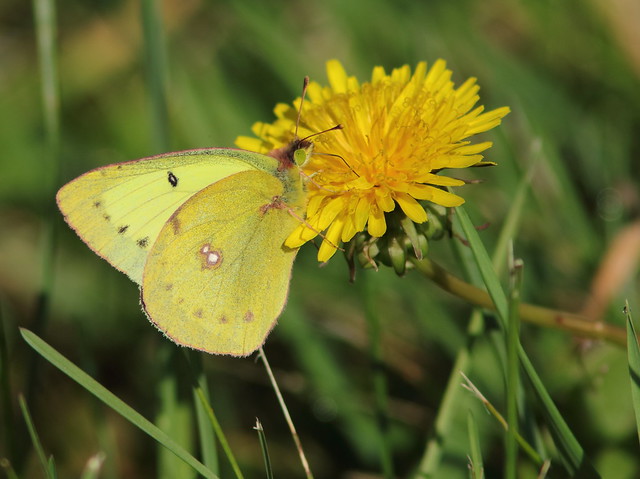 However this year, because of unusual heat and rainfall in late summer and early autumn, most of the trees simply turned from green to brown. Windy storms stripped many of their leaves. Only a few maples showed their red colors.
However this year, because of unusual heat and rainfall in late summer and early autumn, most of the trees simply turned from green to brown. Windy storms stripped many of their leaves. Only a few maples showed their red colors.
On October 14, when trees should have been approaching the height of fall color, the leaves of Cottonwoods along the Fox River at Lippold Park simply "turned loose" rather than "turned yellow:"
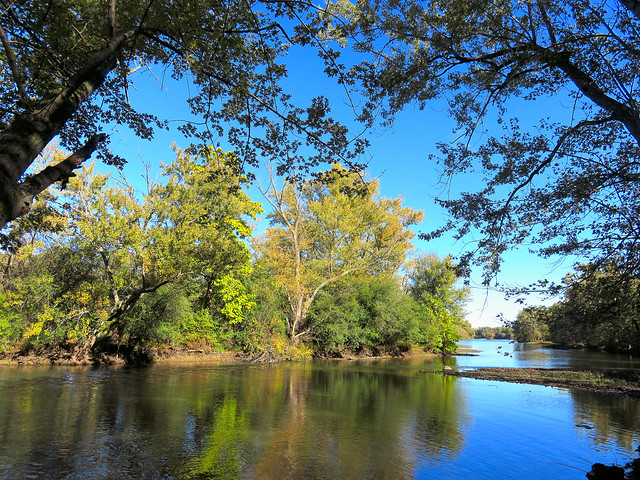
Contrast this with the expected modest show of color in Lippold at the same time just two years ago:
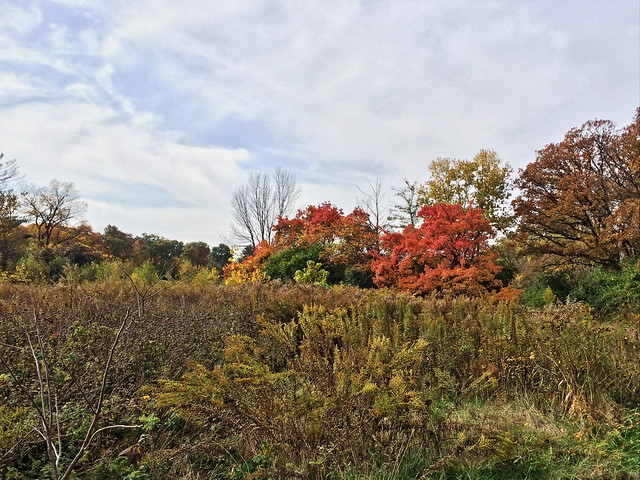
We witnessed passage of flocks of Canada Geese...
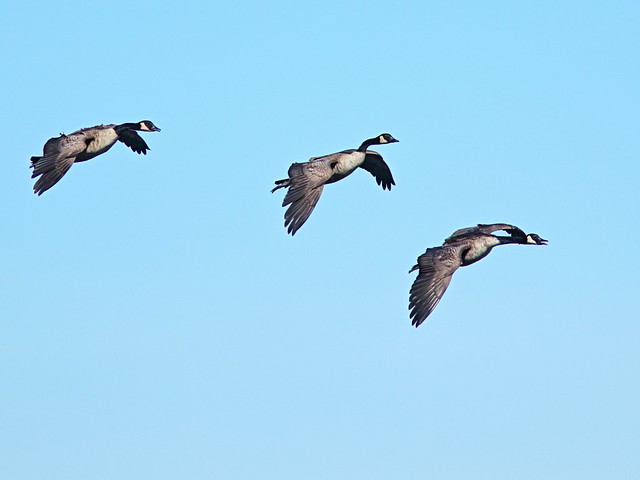
...and family groups of Sandhill Cranes:
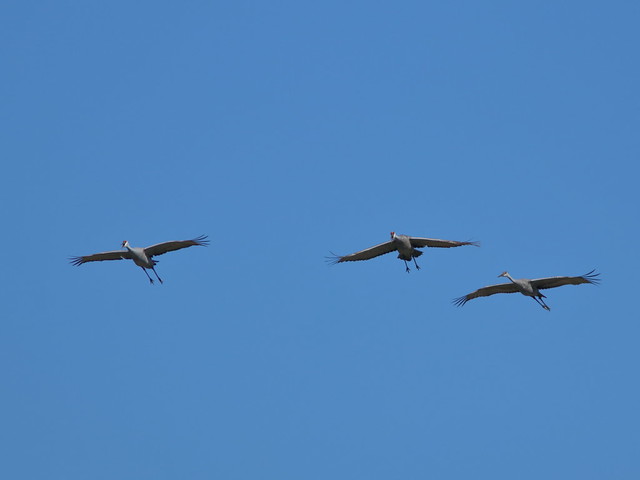
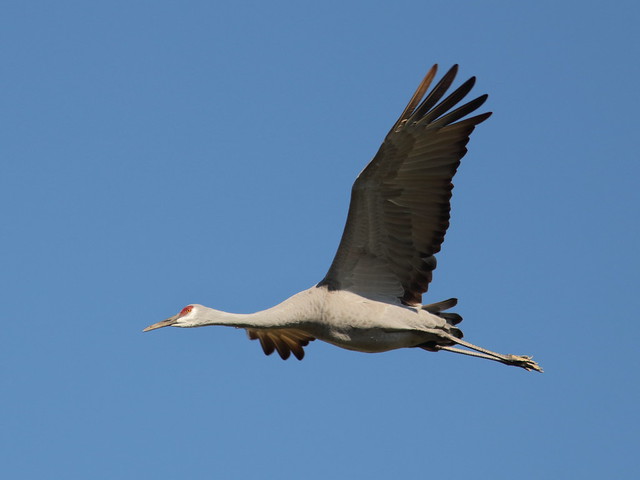
The cranes often called loudly, alerting us to their approach:
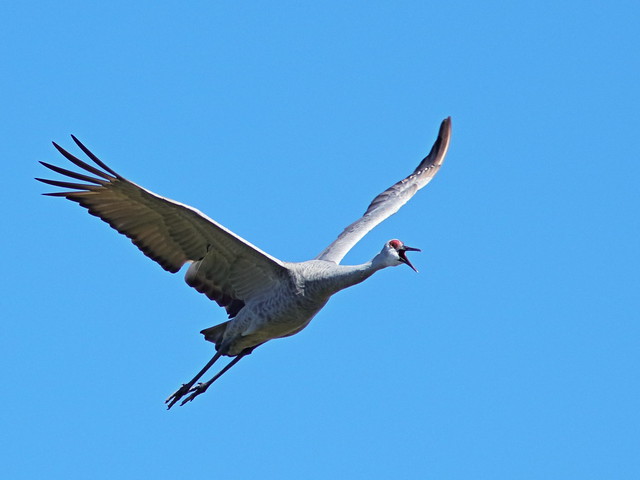
Here a large flock of geese moves in over Jones Meadow Park. A rail fence separates the wild from the manicured and landscaped areas (click for enlarged view):
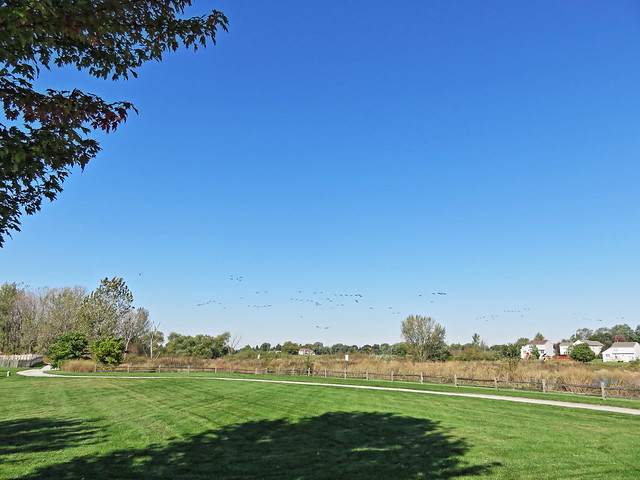
The presence of Yellow-rumped Warblers and winter sparrows signaled that migration of northern-breeding land birds was dwindling down. We hoped that American Tree Sparrows and longspurs might arrive before we departed, and it was yet too early to expect an influx of northern duck species.
One welcome arrival which does not winter in south Florida was this "upside down bird," a Red-breasted Nuthatch, seen at Lippold Park on October 13. Most of my photos were badly back-lighted by the bright sky:
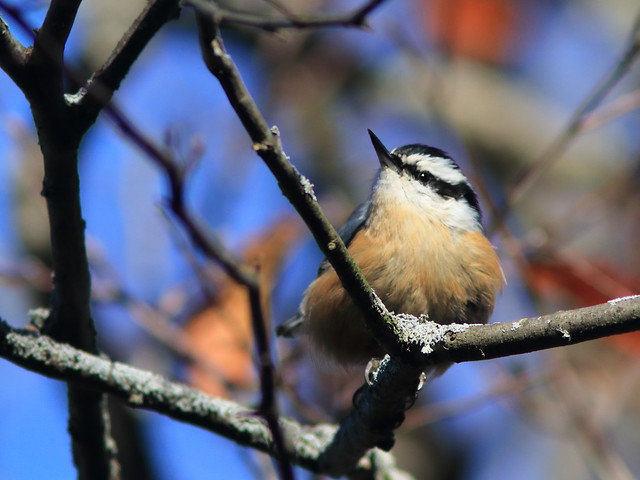
The "upside-down bird" lived up to its reputation:
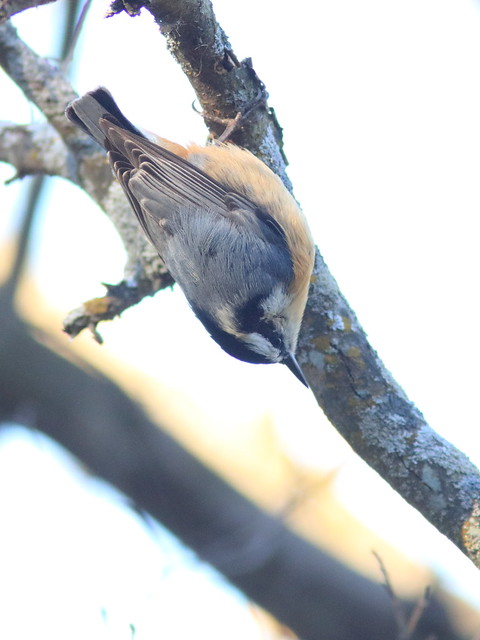
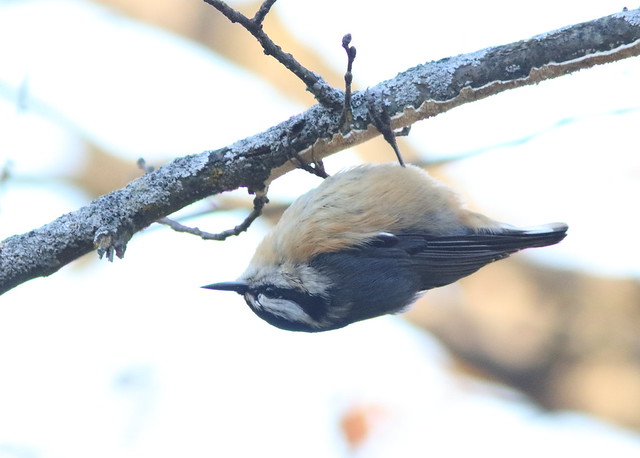
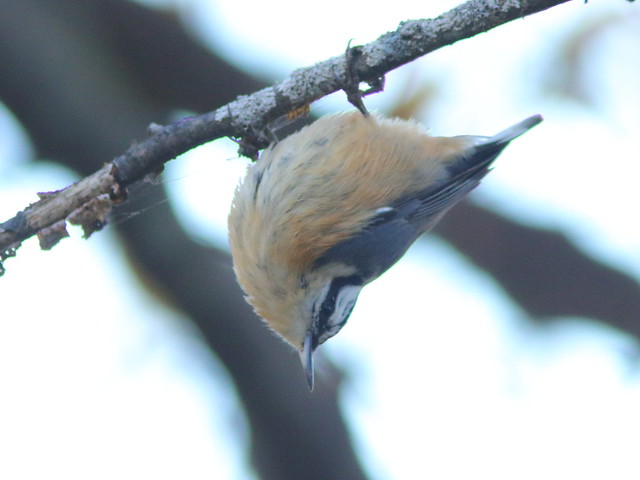
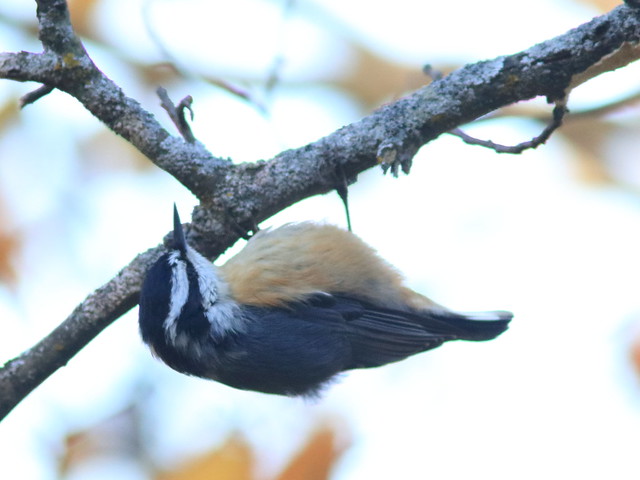
Oddly, this Orange-crowned Warbler followed the nuthatch closely from one tree to another, possibly benefiting from any insects stirred up by the latter's meticulous foraging:
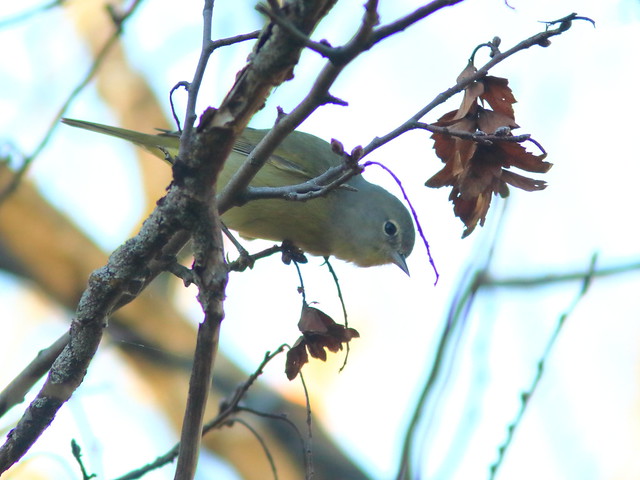
In a cloudless sky, from ground view, these two aircraft appeared to be on a collision course. Suddenly the smaller plane on the right veered down and away, possibly on orders of a flight controller, perhaps because their degree of separation was judged to be unsafe. They were obviously flying at different altitudes:
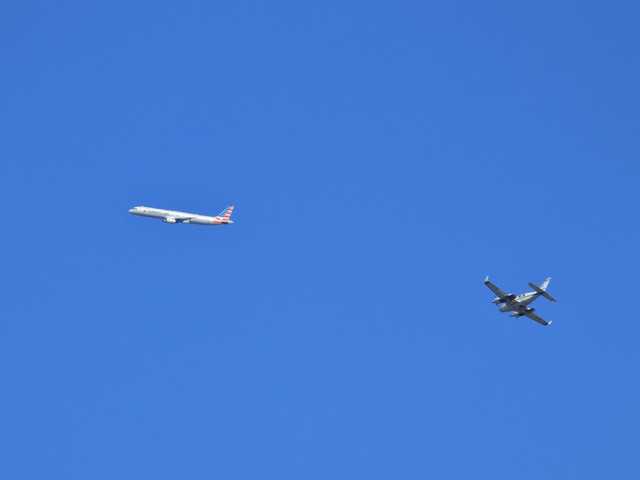
At Hickory Knolls woodlands in St. Charles, fall beauty was "confined." This beautiful maple tree exhibited its rich colors from behind the razor wire fence surrounding the medium security correctional facility:
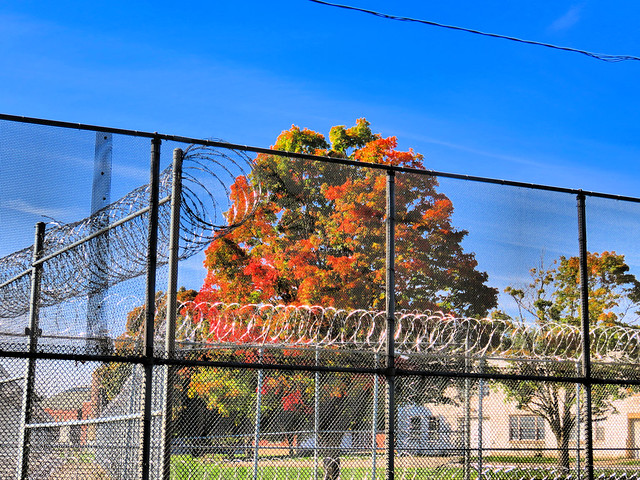
An anonymous "jailbird" perched on the razor wire:
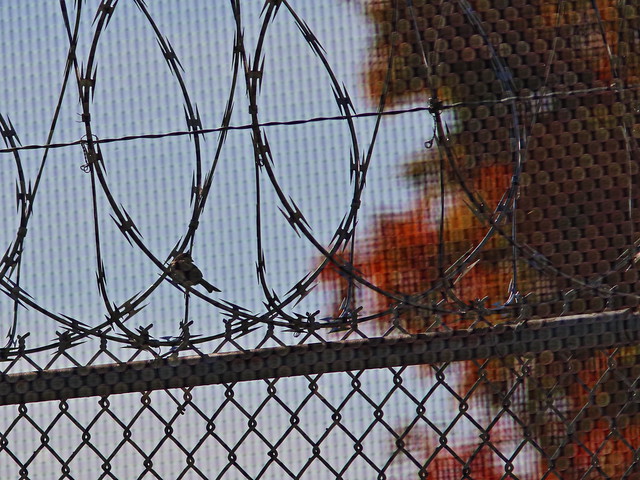
In keeping with a Halloween theme, I found this old stub of a branch protruding from a large oak, also at Hickory Knolls. Does it resemble a rhinoceros, a turtle, or some kind of prehistoric monster?:
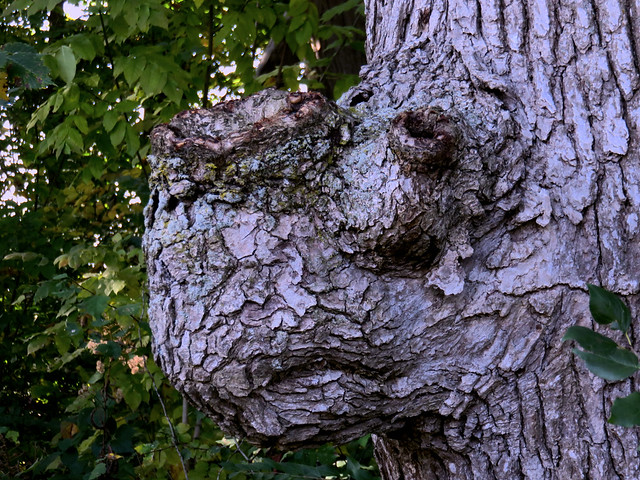 This little bird is not "creepy," rather it is one that I have only rarely photographed, an inconspicuous Brown Creeper circling its way up a tree, unlike the nuthatch which usually works its way down headfirst:
This little bird is not "creepy," rather it is one that I have only rarely photographed, an inconspicuous Brown Creeper circling its way up a tree, unlike the nuthatch which usually works its way down headfirst: 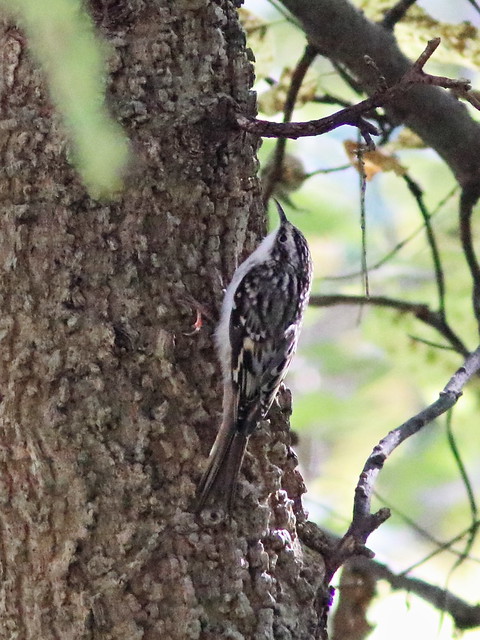
= = = = = = = = = = = = = = =
Linking to Eileen's SATURDAY'S CRITTERS,
Linking to GOOD FENCES by Tex (Theresa),
Linking to SKYWATCH FRIDAY by Yogi, Sylvia and Sandy,
Linking to WEEKEND REFLECTIONS by James
Linking to Misty's CAMERA CRITTERS,
Linking to BirdD'Pot by Anni
Linking to Wild Bird Wednesday by Stewart
Linking to Today's Flowers Friday by Denise
Linking to Wordless Wednesday (on Tuesday) by NC Sue
Please visit the links to all these memes to see some excellent photos on display
We enjoyed rather temperate but stormy weather for a couple of weeks after we arrived in Illinois in late September. Clouds hung low one morning over the silo at Nelson Lake preserve:
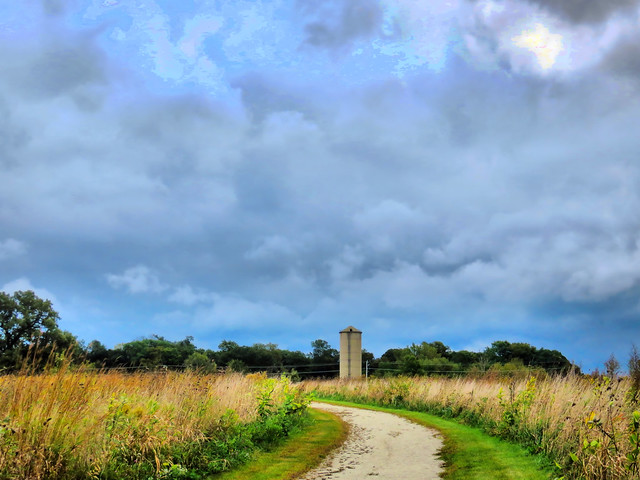
Then, in mid-October, the weather turned cold. Temperatures dropped to near freezing and we had a hard frost overnight. The air was still and we could see our breath when we visited nearby Les Arends Forest Preserve on the Fox River in Batavia. A slight breeze distorted the reflections in this slough along the west side of the river:
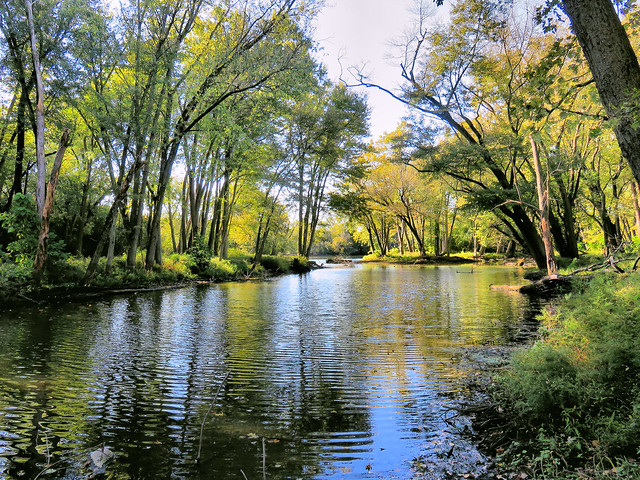
A cluster of Sky Blue Asters (Symphyotrichum oolentangiense), sheltered in the undergrowth, had survived the cold, but their days were numbered:
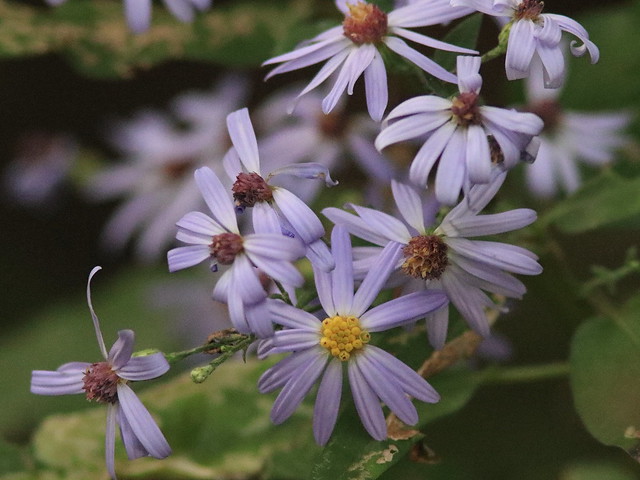
A few White-crowned Sparrows (Zonotrichia leucophrys) were singing their distinctive lisping songs. They reminded me of the nights we spent in a little cabin deep in Denali National Park, Alaska. It was early June and the night sky remained deep blue all night. Around us, White-crowned Sparrows sang incessantly all night. As the light improved we watched them forage only inches away from our window screens.
There are several subspecies of White-crowned Sparrows. Those we saw in Alaska, such as this one, has white lores (the area in front of eye):
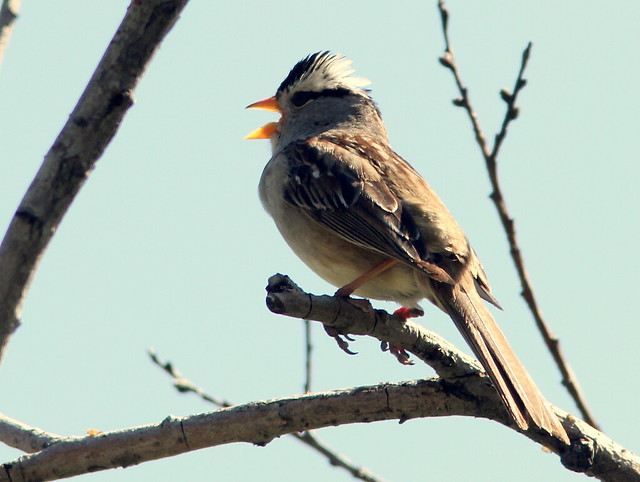
This is one of my favorite photos of this species, taken in Talkeetna, Alaska back in 2011:
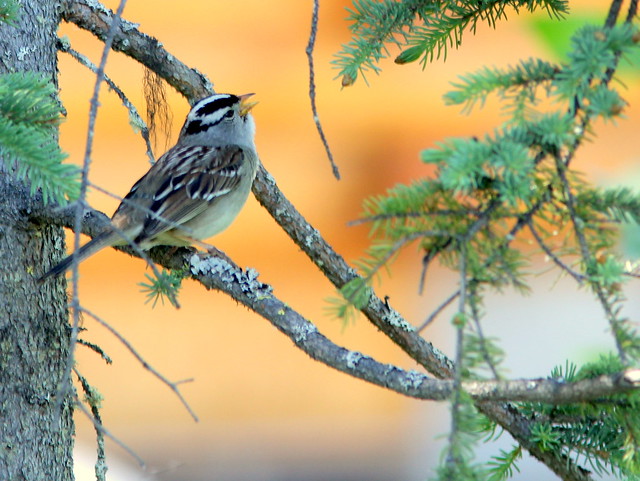
This bird, photographed at Rio Grande Nature Center in Albuquerque, New Mexico, also exhibits white lores:
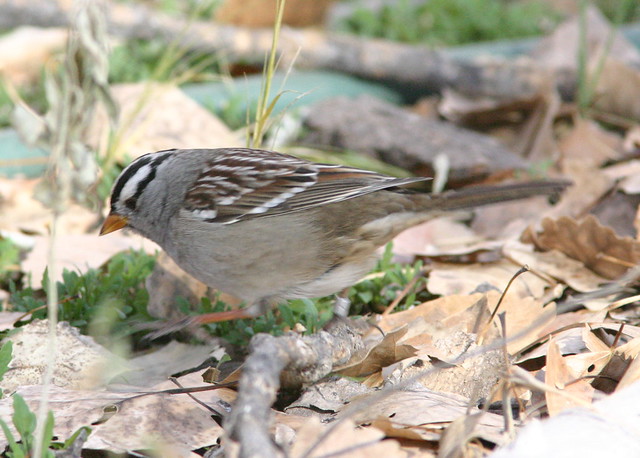
Four subspecies of this rather large sparrow are recognized, and intermediate forms are found where their ranges overlap. They are distinguished by presence or absence of black in their lores, bill color and other subtle plumage variations.
Two of the most widespread subspecies are depicted above. Zonotrichia l. leucophrys breeds in the central and eastern portion of far northern Canada and along the Rocky Mountain chain into Northern New Mexico. It has a pink bill and black lores and spends the winter all across the southern US, more commonly to the east.
Zonotrichia l. gambelli breeds in the western part of far northern Canada and Alaska and has white lores and an orange or pinkish orange bill. In winter it usually migrates into the western US and central Mexico.
While most of the White-crowned Sparrows around our second home in northeastern Illinois have dark lores, this one, seen at Fabyan Forest Preserve in Geneva, Illinois exhibited white lores:
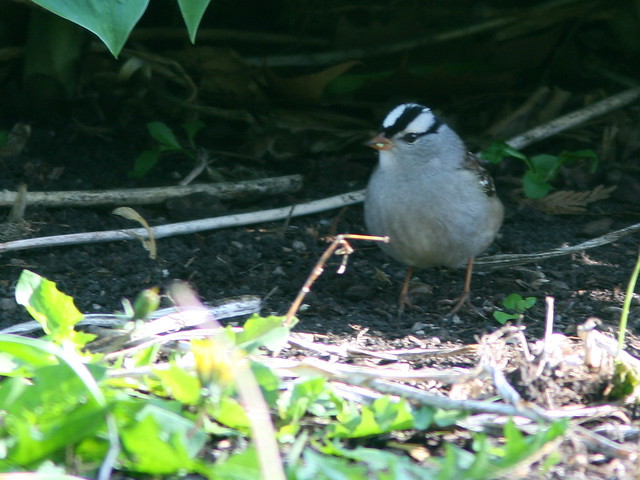
My best photos of this species have been taken from the comfort of the back yard deck at our daughter's home in Batava, Illinois. They maintain several feeders and the birds are quite tame, often perching on the railing or furniture. Note that this bird has dark lores:
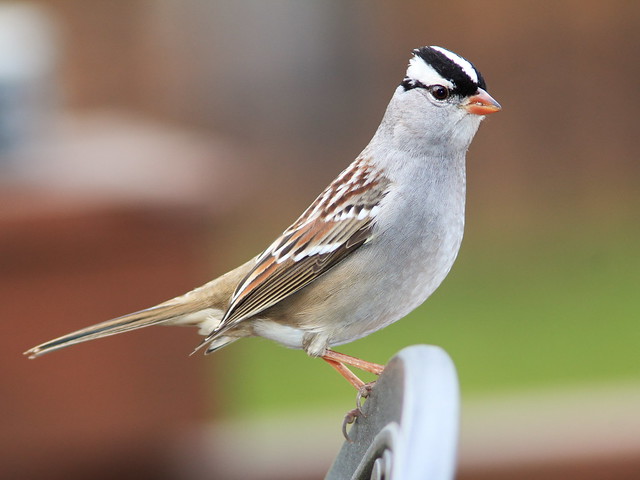
This one peers through their back yard fence:
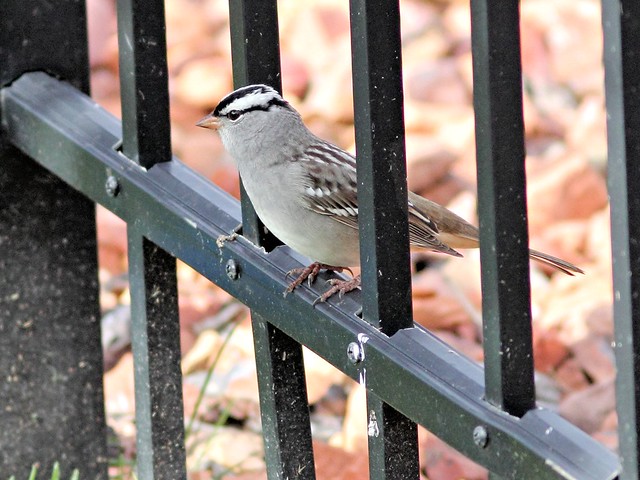
So far I have shown only adult birds. For the first year of its life the streaks on its head and behind the eye are reddish brown rather than black, and the central crown stripe and those over its eyes are light tan rather than white:
White-crowned Sparrows are quite rarely seen in the southern tip of Florida. I was lucky to find and photograph them there on two occasions, in mid and late October two years in a row. All were immature birds. This one appeared on October 23, 2013, a year after my first sighting on October 18, 2012:
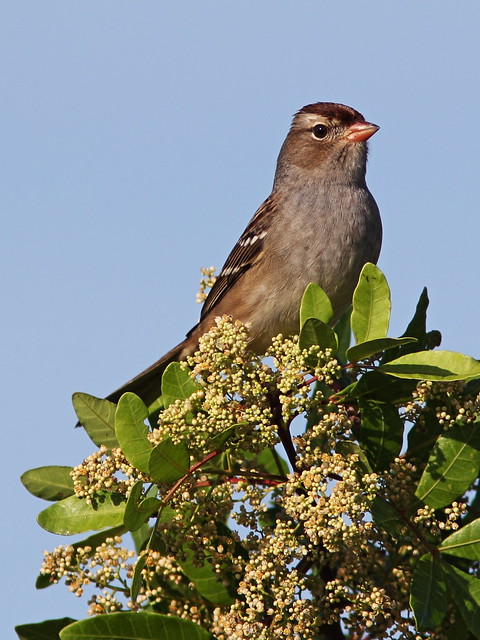
This immature visited our daughter's back yard in October, 2014:
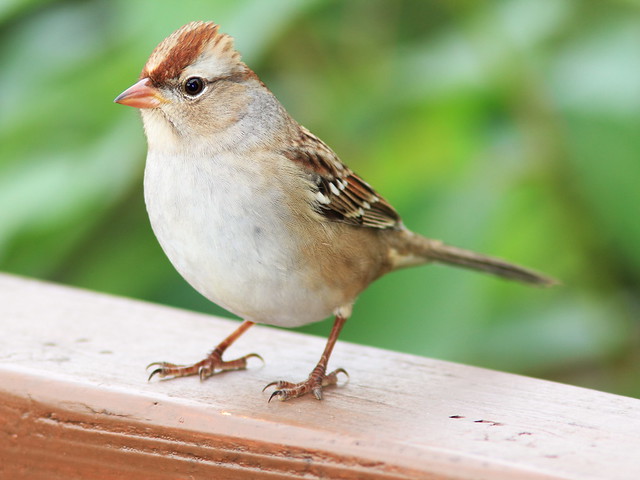
This past week the feeders in our daughter's back yard had run out but there was some seed scattered on the deck. Two immature White-crowned Sparrows flew in and perched on the deck railing at eye level only about 4 feet from where I was sitting (photographing a junco in nearby tree).
They were too close to focus and also more than filled the viewfinder of my telescopic lens system, so I cautiously switched on the macro setting. One bird flew but the other remained for a few seconds, enough for a burst of close-ups:
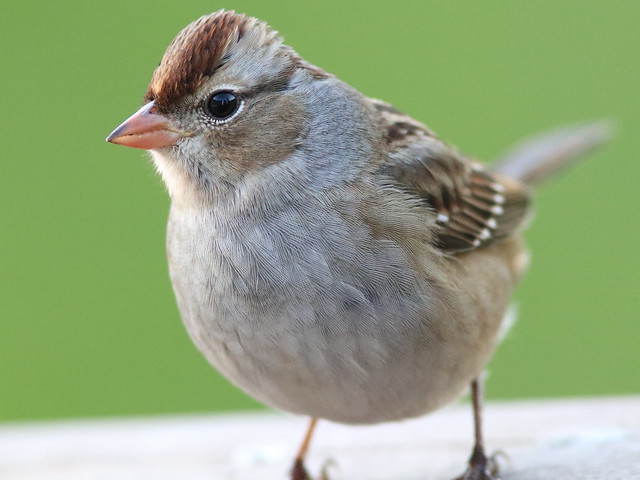
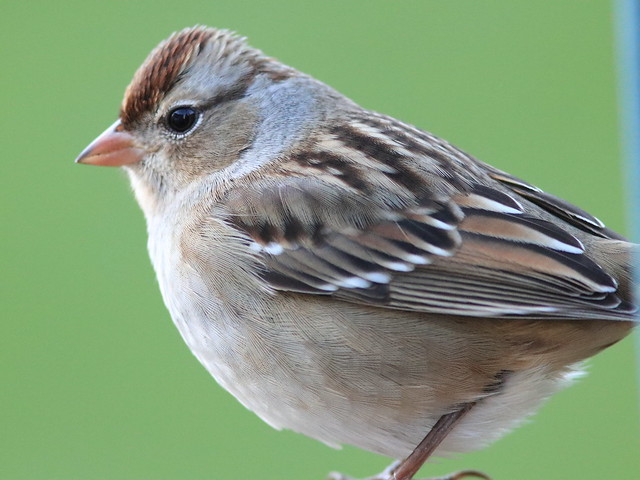
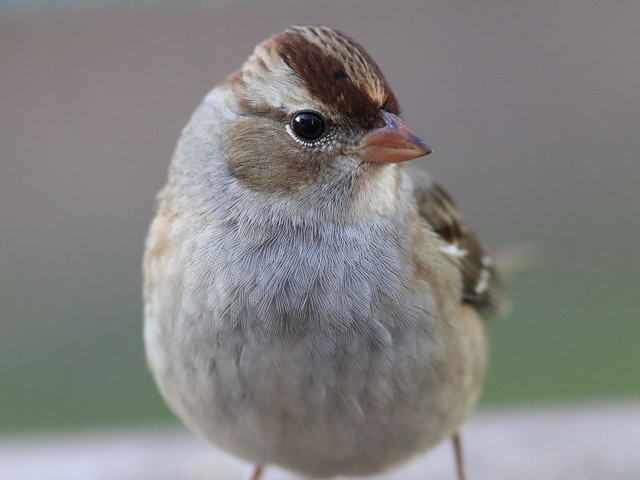
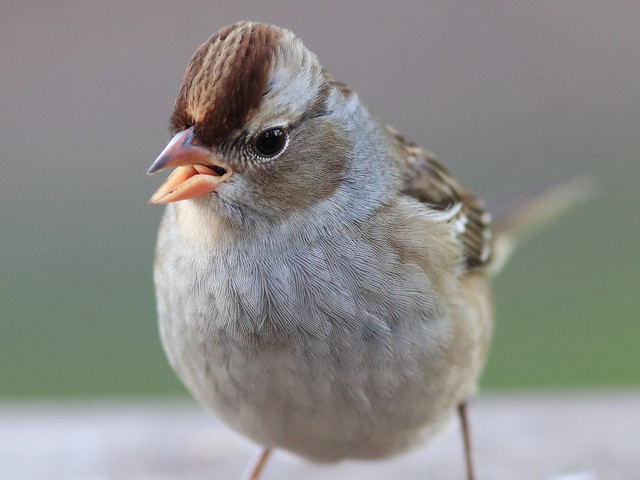
Here is the Dark-eyed (Slate-colored) Junco which was the initial object of my attention:
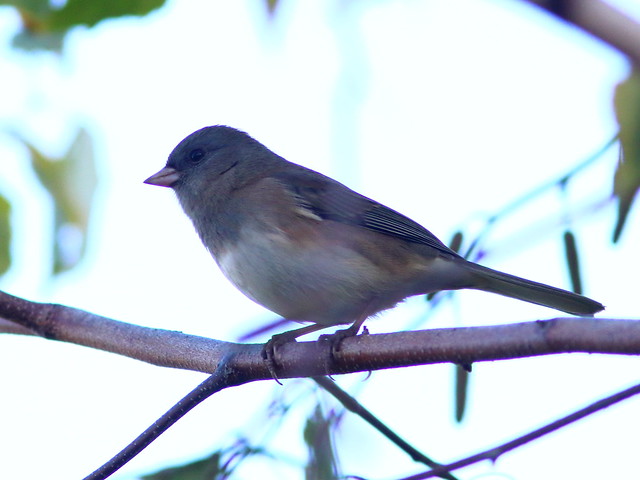
I have had difficulties with Blogger fonts and formatting and finally needed to re-write this blog using a default template, hence the difference in appearance.
= = = = = = = = = = = = = = =
Linking to Misty's CAMERA CRITTERS,
Linking to Eileen's SATURDAY'S CRITTERS,
Linking to GOOD FENCES by Tex (Theresa).
Linking to SKYWATCH FRIDAY by Yogi, Sylvia and Sandy
Linking to WEEKEND REFLECTIONS by James
Linking to BirdD'Pot by Anni
Linking to Wild Bird Wednesday by Stewart
Linking to Today's Flowers Friday by Denise
Linking to Wordless Wednesday (on Tuesday) by NC Sue
________________________________________________
Please visit the links to all these memes to see some excellent photos on display
________________________________________________
Our stay at our second home in northeastern Illinois coincides with the visible signs of the changing seasons. In Florida, we slip seamlessly from wet season to dry, with no noticeable change in the foliage. Here in Illinois, the prairie has turned to gold, and the slightest breeze sends leaves flying from the trees.
This path at nearby Nelson Lake/Dick Young Marsh county preserve runs along the south end of the lake:
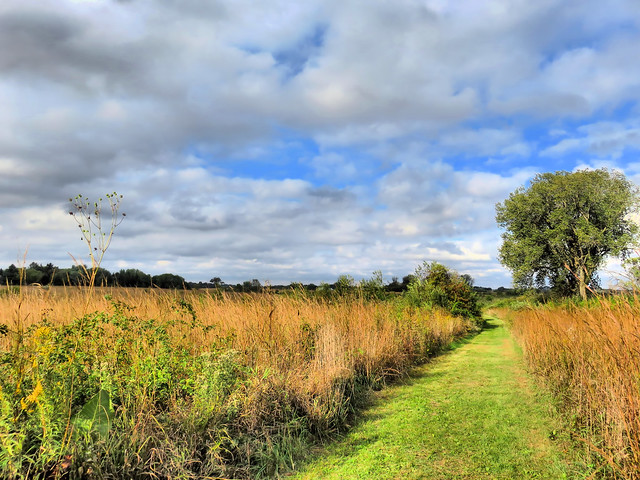
A wide view of the lake:
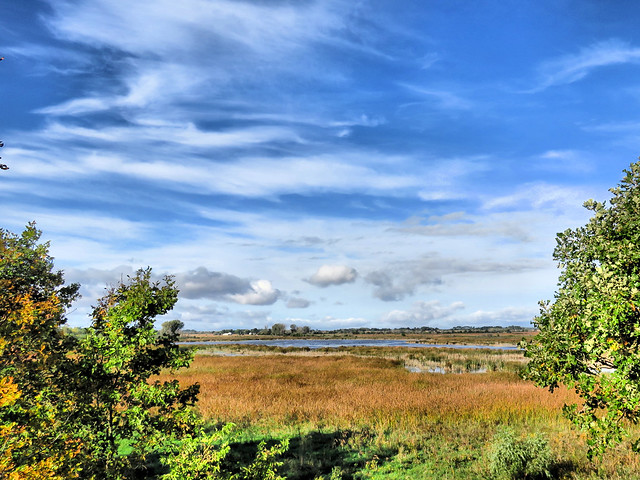
On the lake we "discovered" a flock of fourteen migratory American White Pelicans, but then learned that they had already been reported a couple of days earlier:
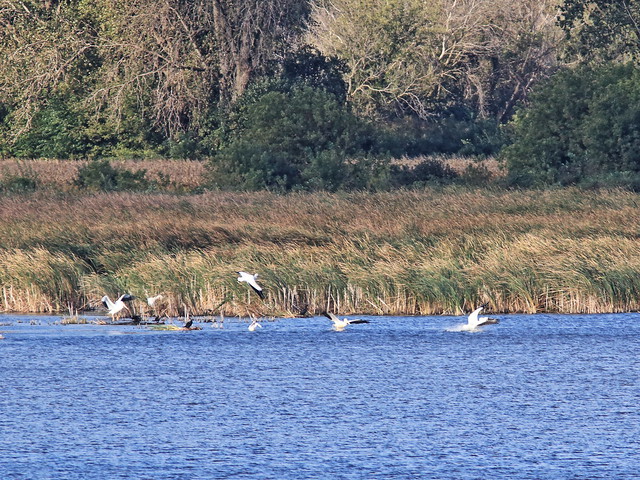
A Gray Squirrel watched me from a tree along the trail:
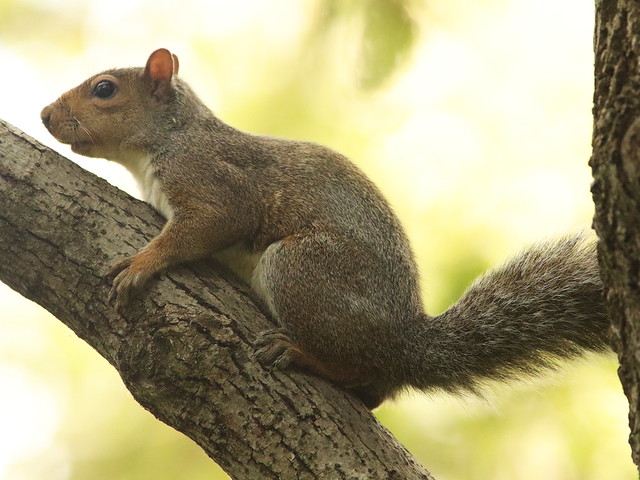
Cedar Waxwings were plentiful, helping themselves to the numerous berries:
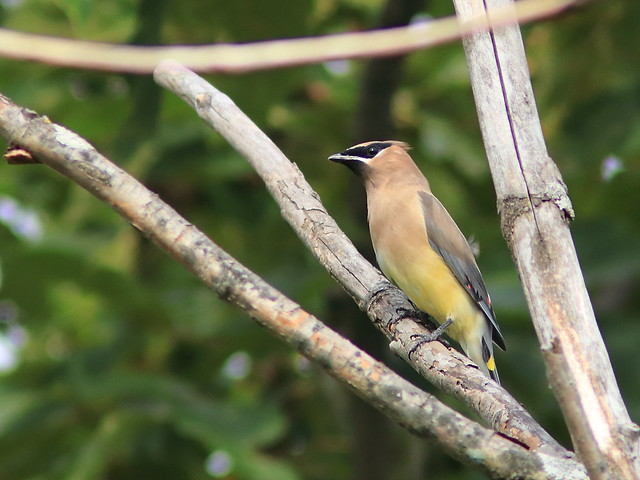
A cold snap curtailed the butterflies, but during the prior week they added color to the landscape. A Red Admiral gleaned nectar from the Heath Asters along the path:
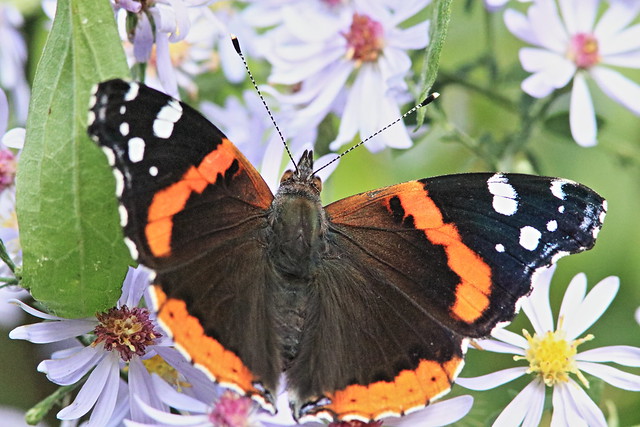
A Painted Lady put in an appearance:
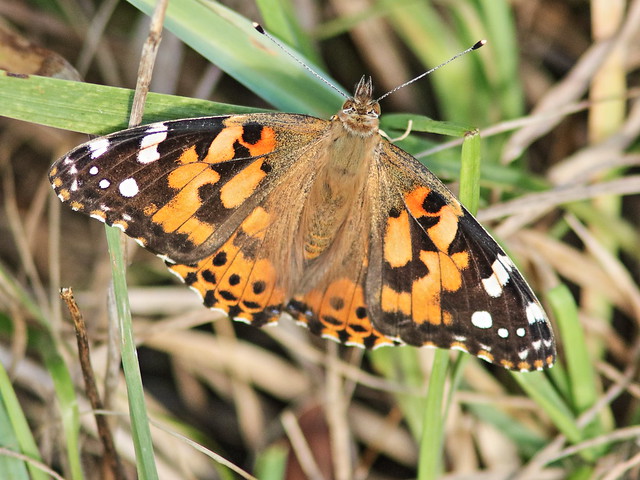
Sparrows were suddenly in season, and a mixed flock got my attention. They blended so beautifully with the high grasses that I rarely got good "field guide" images with my new camera, a Canon EOS 80D. Although my subjects were usually partially hidden, I loved the monochromatic effect as I viewed them through gaps in the blades--
Immature White-crowned Sparrow:
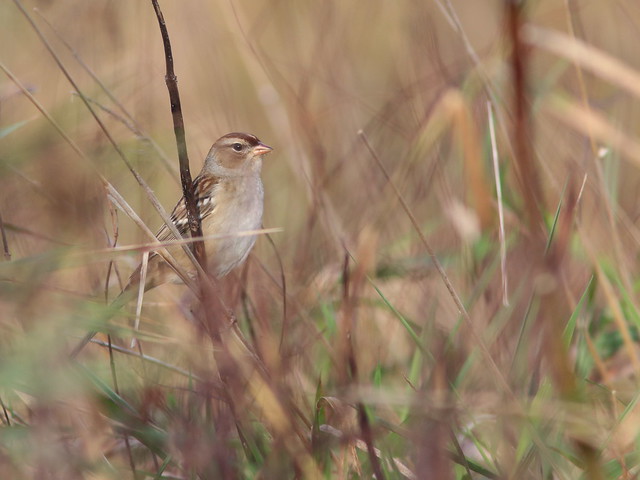
Song Sparrow:
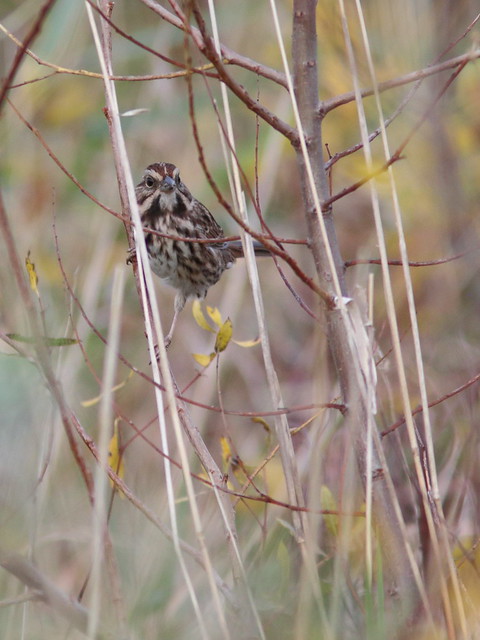
Swamp Sparrow:
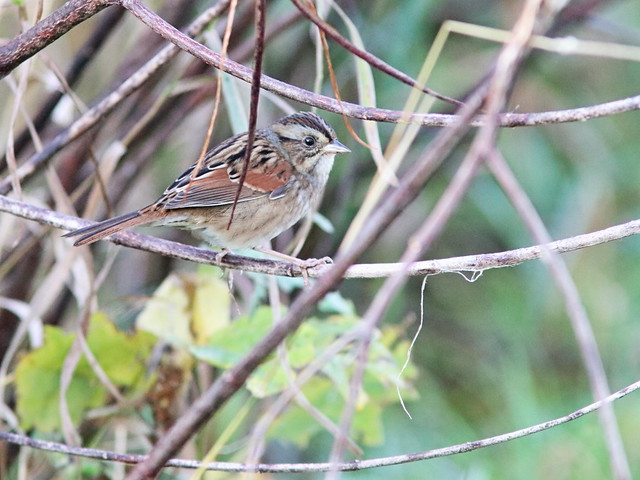
Lincoln's Sparrow:
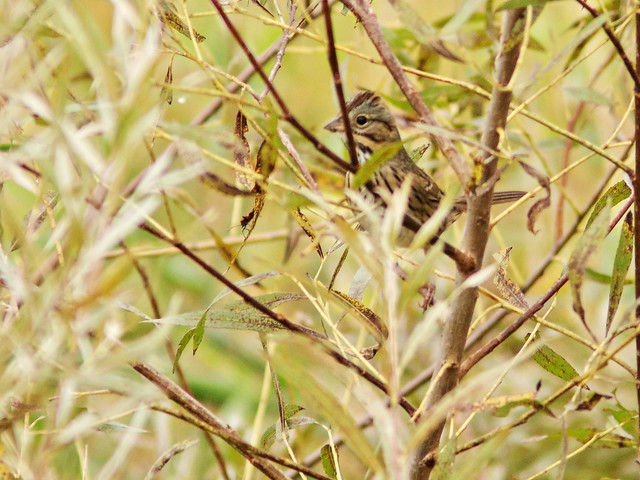
Adult White-crowned Sparrow:
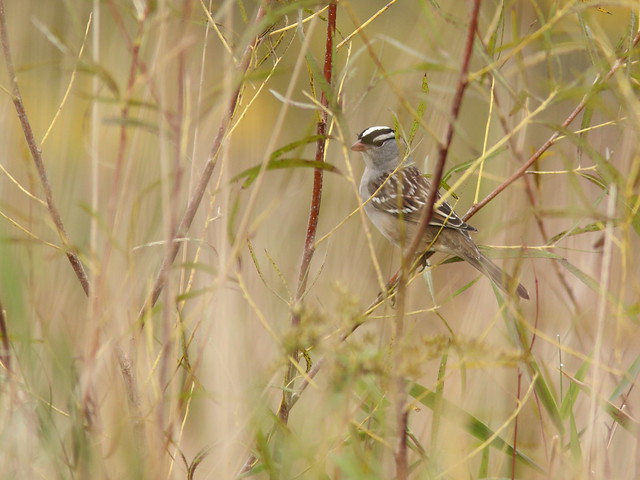
My photos were all taken without a flash, often under heavily overcast skies, but I was pleased with the low-light performance of my new camera. This shot of a White-throated Sparrow hiding deep within a thicket came out surprisingly bright:
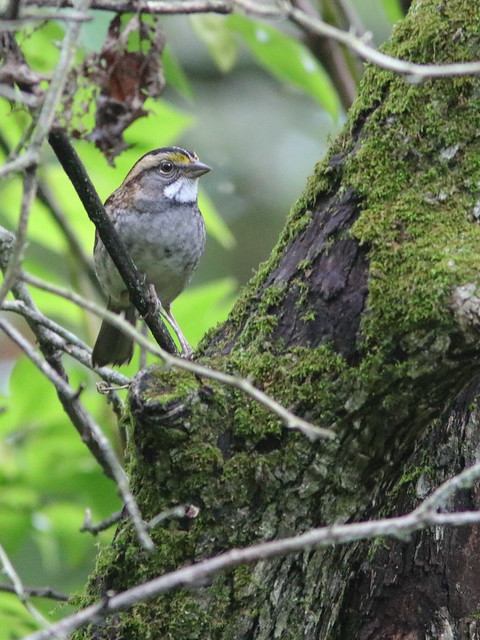
This Savannah Sparrow posed briefly out in the open:
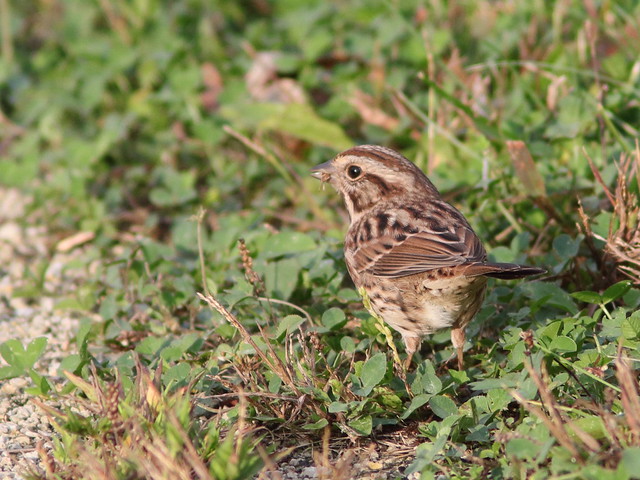
My patience in pursuing a Swamp Sparrow paid off when it unexpectedly landed out in the open on the path just in front of me:
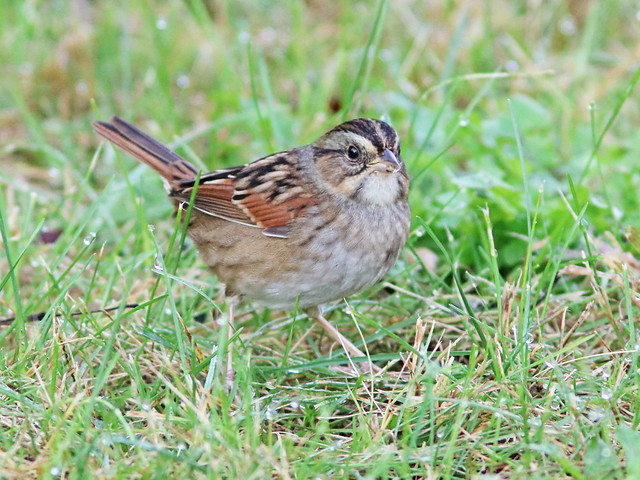
I also obtained a clear photo of another Lincoln's Sparrow:
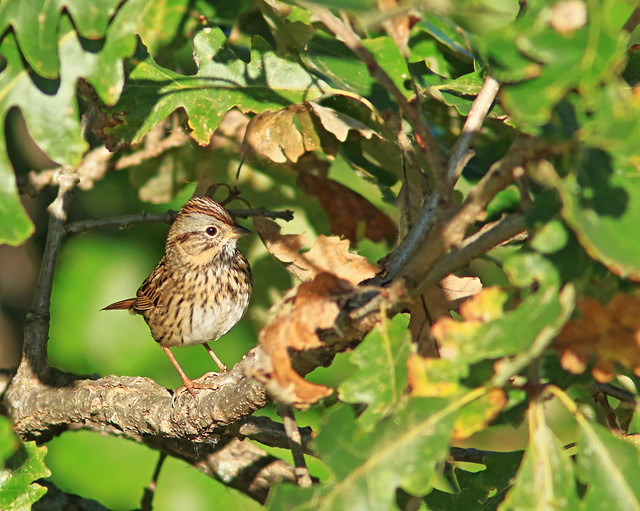
As if on cue, a Black-capped Chickadee plunged into a sea of bokeh created by autumn leaves:
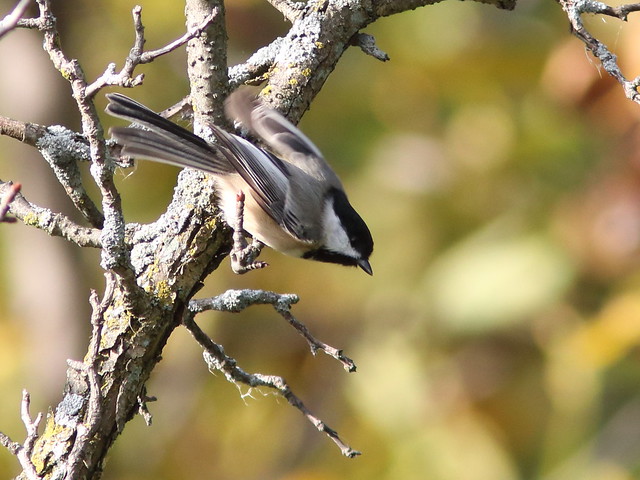
A White-crowned Sparrow flew up into a small oak tree to provide the day's favorite image:
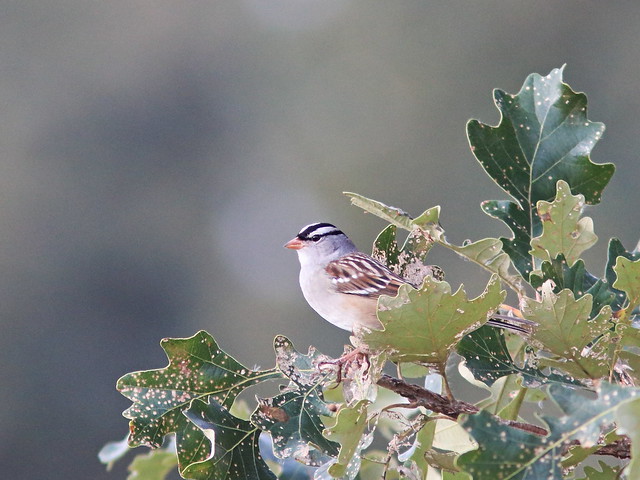
Our daughter's Tibetan Mastiff, Siboney, is now almost 11 months old and weighs over 100 pounds...
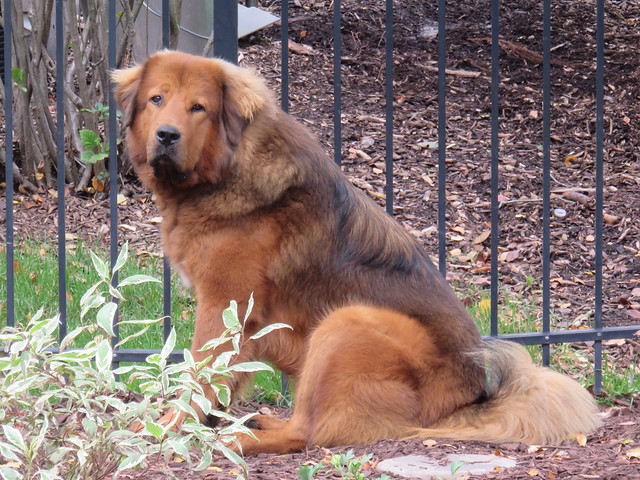
...out-sized by 130-pound Agramonte:
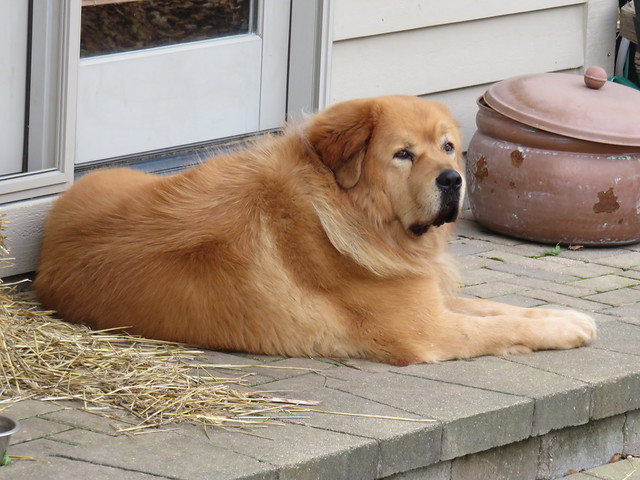
Windy weather spoiled most of my "reflections," but the water was reasonably placid for this view of the Fox River from Lippold Park:
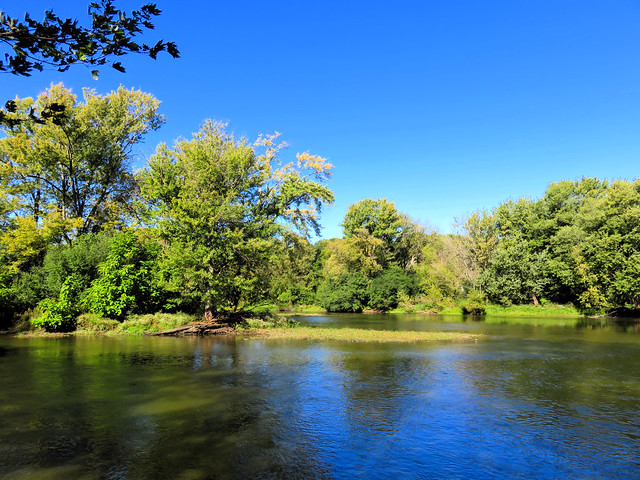
Under fair skies, leaves are beginning to turn on the majestic twin oaks near the entrance of Nelson Lake:
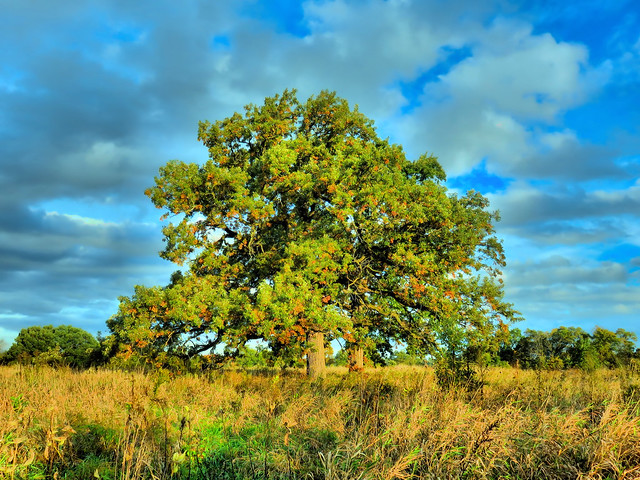
In keeping with the theme, an Eastern Bluebird found a very appropriate landing place on a sign advertising yet another new development near us:
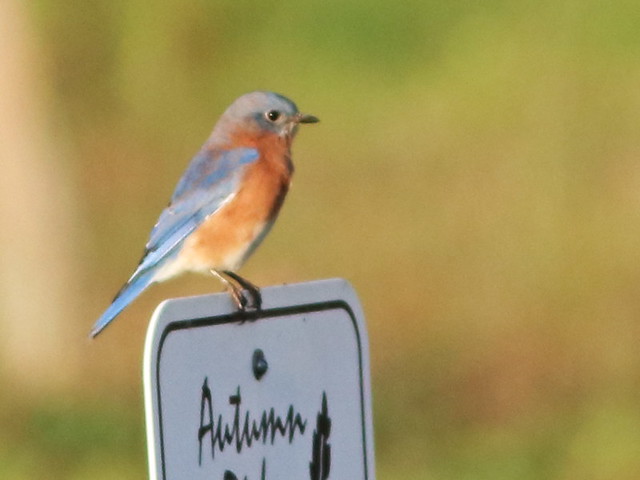
A Great Horned Owl has been calling most mornings from our roof or those of neighboring condos, but it always flies away well before sunrise. In an ultimate test of my new camera I took this hand-held image as it roosted on the roof across from us. I tried to stabilize the camera against the window pane. At ISO 6400 the shutter speed was 1/4 second. Oh, well, there is a limit to the low-light performance of my new gear!:
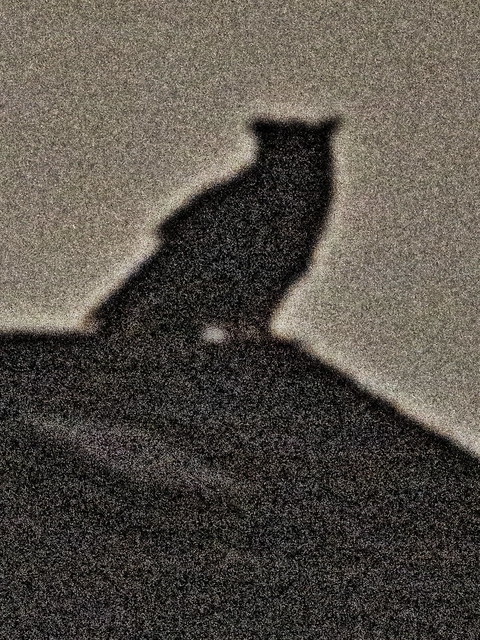
 However this year, because of unusual heat and rainfall in late summer and early autumn, most of the trees simply turned from green to brown. Windy storms stripped many of their leaves. Only a few maples showed their red colors.
However this year, because of unusual heat and rainfall in late summer and early autumn, most of the trees simply turned from green to brown. Windy storms stripped many of their leaves. Only a few maples showed their red colors. 
























































